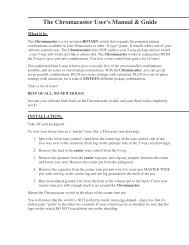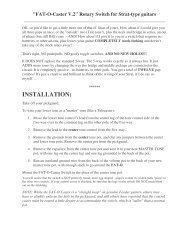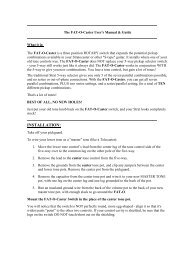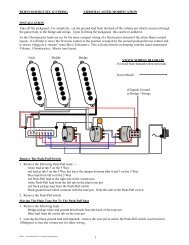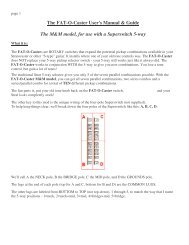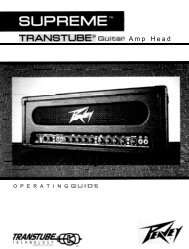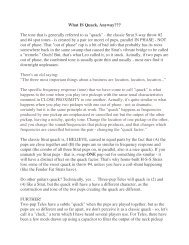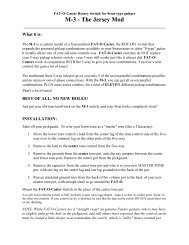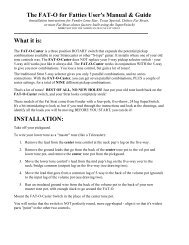FAT-O-Caster V.3 - Deaf Eddie
FAT-O-Caster V.3 - Deaf Eddie
FAT-O-Caster V.3 - Deaf Eddie
Create successful ePaper yourself
Turn your PDF publications into a flip-book with our unique Google optimized e-Paper software.
"<strong>FAT</strong>-O-<strong>Caster</strong> <strong>V.3</strong>" Rotary Switch for Strat-type guitars<br />
_________________________________________________________<br />
What it is:<br />
The <strong>FAT</strong>-O-<strong>Caster</strong> <strong>V.3</strong> is a four-position ROTARY switch that expands the potential pickup<br />
combinations available in your Stratocaster or other "S-type" guitar. It installs where one of your<br />
old tone controls was. The <strong>FAT</strong>-O-<strong>Caster</strong> <strong>V.3</strong> does NOT replace your 5-way pickup selector<br />
switch - your 5-way still works just like it always did. The <strong>FAT</strong>-O-<strong>Caster</strong> <strong>V.3</strong> works in<br />
conjunction WITH the 5-way to give you new combinations. You lose a tone control, but gain a<br />
lot of tones – it goes to ELEVEN!<br />
The traditional Strat 5-way selector gives you only five of the seven parallel combinations<br />
possible, and no series or out-of-phase connections. With the <strong>FAT</strong>-O-<strong>Caster</strong> <strong>V.3</strong>, you can get all<br />
seven parallel combinations, PLUS some series, series/parallel and series/out of phase<br />
combos, for a total of eleven different pickup combinations.<br />
That's a lot of tones!<br />
BEST OF ALL, NO NEW HOLES!<br />
Just put your old tone knob back on the <strong>FAT</strong>-O-<strong>Caster</strong> <strong>V.3</strong> switch, and your Strat looks<br />
completely stock!<br />
INSTALLATION:<br />
Take off your pickguard.<br />
To wire your lower tone as a "master" tone (like a Telecaster):<br />
1. Move the lower tone control’s lead from the center lug of the tone control side of the<br />
five-way over to the common lug on the other pole of the five-way.<br />
2. Remove the lead to the center tone control from the five-way.<br />
3. Remove the grounds from the center tone pot, and clip any jumpers between the center<br />
and lower tone pots. Remove the center pot from the pickguard.<br />
4. Remove the capacitor from the center tone pot and wire it to your new MASTER TONE<br />
pot, with one leg on the center lug and one leg grounded to the back of the pot.<br />
5. Run an insulated ground wire from the back of the volume pot to the back of your new<br />
master tone pot, with enough slack to go around the <strong>FAT</strong>-O.<br />
Mount the <strong>FAT</strong>-O-<strong>Caster</strong> Switch in the place of the center tone pot.<br />
You will notice that the switch is NOT perfectly round, more egg-shaped - align it so that it's widest parts "point" to<br />
the other two controls. If your control cavity is shielded, be sure that the lugs on the switch DO NOT touch/short out<br />
on the shielding.
Your stock Strat probably looks like this…<br />
Remove the center pot and wire the lower tone pot like this for a<br />
MASTER TONE CONTROL:
WIRING THE <strong>FAT</strong>-O-<strong>Caster</strong> <strong>V.3</strong> Switch:<br />
The center lugs:<br />
Unsolder the bridge pup leads from where they are currently in your guitar and solder them to<br />
the center lugs on the <strong>FAT</strong>-O-<strong>Caster</strong> <strong>V.3</strong>. Be sure you get the GROUND ("-") lead on lug "1"<br />
(with the string tied through it) and the "positive" (hot) on lug "2" clockwise (see drawing).<br />
Now your bridge pup goes through the <strong>FAT</strong>-O-<strong>Caster</strong> <strong>V.3</strong>.<br />
NOTE: Sometimes there is not enough wire on the leads to make it to the <strong>FAT</strong>-O, so just add on<br />
a little "tail" to the lead to get there. Be sure you insulate the solder joint on this "tail" to prevent<br />
contact with the pots or any other grounded surface in the control cavity – black electrical tape<br />
will do…<br />
What about THREE-wire pickups?<br />
Some guitars and many after-market pickups are wired with THREE conductors:<br />
The coil's "+" lead, the coil's "-" lead, and the shield/ground lead.<br />
In these cases, remember that the shield/ground STAYS on the guitar's ground, and you will be<br />
lifting the coil's "-" lead - which is often "twisted" with the shield/ground lead - to move it over<br />
to the rotary switch. How to tell which is the coil's "-" and which is the ground lead? IF you<br />
don't have any "paperwork" color-code indicating which is which, a simple test is to use your<br />
multimeter. With the two leads/conductors unsoldered from ground (typically the back of the<br />
volume pot) and separated, set your multimeter in the 20k ohm range. With one probe on the<br />
lead that you know is the coil's "+" lead (it's the one on the pup selector switch), one of the other<br />
two leads will show you a 5k -10k reading when touched with the other probe. That's the<br />
resistance number for your pup, and that's the coil's "-" lead. It is the lead you will move over to<br />
the rotary switch - the other one is soldered back to ground. The same idea works if you have a<br />
four-conductor pickup in your bridge spot, like a Hot Rails or single-coil sized humbucker – the<br />
hot and negative leads go to the <strong>FAT</strong>-O, the “series-pair” stays soldered together, and the bare<br />
wire stays soldered to ground on the back of the volume pot.<br />
The pre-wired leads:<br />
The WHITE lead from the <strong>FAT</strong>-O-<strong>Caster</strong> goes to the bridge pup’s spot on the<br />
5-way - where you just removed its "positive" (hot) lead.<br />
The RED lead is soldered to the 5-way switch. It goes on the third lug (would be the bridge lug)<br />
of the second pole of the selector switch (the side used to connect the tone pots - see drawing).<br />
The BLACK lead is added to the neck pup's lug on the 5-way.<br />
The BARE wire is soldered to (any) ground.<br />
Put your pickguard back on, and you're ready to rip!
Move the bridge pup leads to the <strong>FAT</strong>-O-<strong>Caster</strong> <strong>V.3</strong><br />
and hook up the prewired leads like this:<br />
The wire colors on the stock stuff might not be the same as the drawing,<br />
but the <strong>FAT</strong>-O-<strong>Caster</strong> <strong>V.3</strong> COLORS ARE CORRECT.
Here are a few more Strat 5-ways:<br />
The 5-way from Stewart-Macdonald and others.<br />
Note that the common lugs are at the opposite end<br />
of the switch from the stock Fender 5-way drawing:<br />
The MEGA-S switch’s lugs are in a completely different configuration:<br />
If NONE of these 5-ways matches yours, e-mail me at eb@deaf-eddie.net<br />
and we’ll figure out a scheme & drawing to git-r-done!
Wuzzit do?<br />
Well, for starters, you now can select from 11 different pickup and phasing combinations!<br />
Yes, some of the tones are repeated - but that's what makes this thing so darn easy to use…<br />
So, WHAT are the new tones, and WHERE are they?<br />
I like to count the settings this way: the <strong>FAT</strong>-O-<strong>Caster</strong> <strong>V.3</strong> switch has “notches” we'll call 1, 2,<br />
3 and 4, numbered as you turn the switch COUNTER-CLOCKWISE. So, if it was a tone control<br />
on “10”, you would be at notch 1. As you turn the control “down,” like from ten to, say, six, you<br />
go through the notches 1 through 4. Remember that even though the bridge pup now goes<br />
completely through the <strong>FAT</strong>-O-CASTER <strong>V.3</strong> switch, the 5-way still controls the tones - here's<br />
what to expect from the 5-way at each <strong>FAT</strong>-O-CASTER <strong>V.3</strong> notch:<br />
Notch 1 (“tone knob” on “10”) is just normal Strat tones.<br />
NOTE: As a reference for the rest of these instructions:<br />
On the 5-way: 1=neck, 2=middle and neck, 3=middle, 4=middle and bridge, 5=bridge<br />
Notch 2 (“tone knob” on “9”) is the "NECK on with BRIDGE" setting –<br />
the neck pup is ALSO routed to the bridge end of the 5-way switch.<br />
The combos are all wired parallel.<br />
As you throw the 5-way in this setting, you get (from 1 to 5):<br />
1 = neck<br />
2 = neck and middle<br />
3 = middle<br />
4 = bridge, middle, and neck<br />
5 = bridge and neck<br />
There now, isn't that what you've always said you wanted your Strat to be able to do?<br />
Notch 3 (“tone knob” on “8”) is the "BRIDGE and NECK series" setting.<br />
In 1,2 and 3 it's normal Strat combos<br />
In 5, you get the bridge and neck in series - it's as Gibson-y a tone as yer Strat ever gets<br />
In 4, you get the bridge and neck in series plus the middle parallel.<br />
Notch 4 (“tone knob” on “7”) is the “BRIDGE and NECK SERIES, out of phase" setting.<br />
In 1,2 and 3 it's normal Strat combos<br />
In 5, you get the bridge and neck in series/out of phase.<br />
In 4, you have the bridge and neck series/out of phase parallel to the middle.<br />
It’s not your typical thin out of phase – this one has some bite because it’s in series.<br />
To me, it strongly recalls Albert King’s tone…<br />
Hey, e-mail me with any questions, comments, or suggestions! EB@deaf-eddie.net
<strong>FAT</strong>-O-<strong>Caster</strong> <strong>V.3</strong> TONE CHART<br />
NOTCH NAME<br />
(across)<br />
Normal<br />
(10)<br />
Neck on with Bridge<br />
(9)<br />
Bridge/neck SERIES<br />
(8)<br />
Bridge/neck SERIES,<br />
Bridge out of phase (7)<br />
5-way (down)<br />
(1) neck n n n n<br />
(2) middle+neck m+n m+n m+n m+n<br />
(3) middle m m m m<br />
(4) bridge+middle b+m B+N+M B*N+M -B*N+M<br />
(5) bridge b B+N B*N -B*N<br />
The <strong>FAT</strong>-O-<strong>Caster</strong> changes the way the pickups are wired into the circuit.<br />
The NAMES of the NOTCHES describe HOW the pickups are wired...



